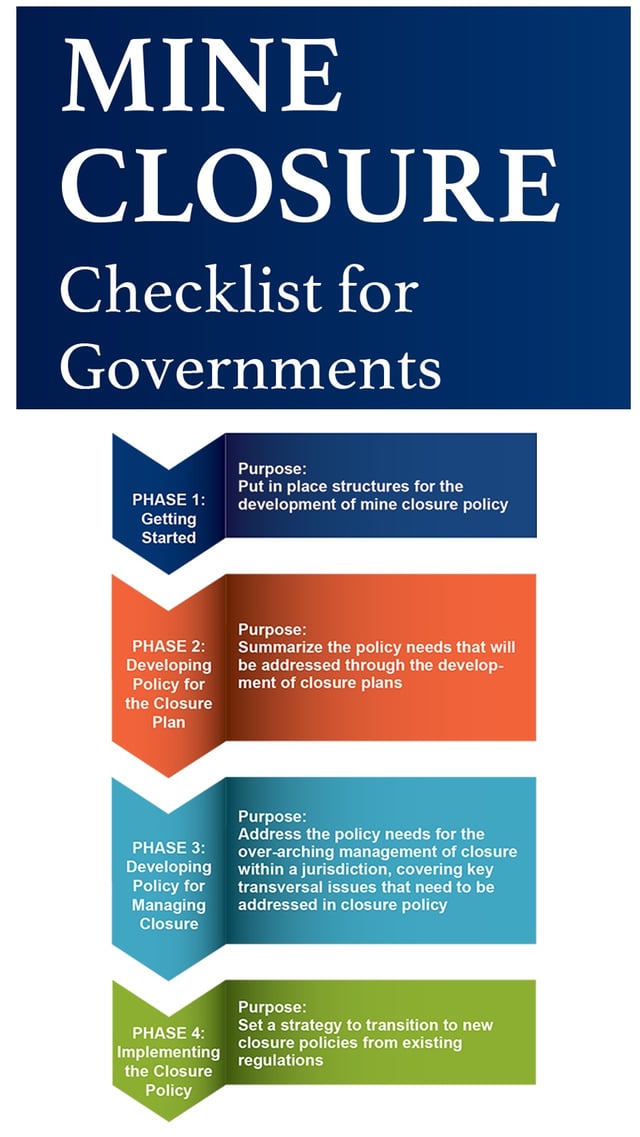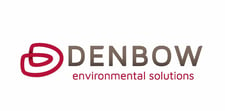"Protecting the environment while encouraging investment; it pays to design with closure in mind."
Golder Associates and Nature Resources Canada have produced a Mine Closure Checklist for Asia-Pacific Economic Cooperation (APEC).
About Mine Closure
"All mines have a finite life span. Mining operations are based around the extraction and processing of mineral deposits. Once the economically available products have been extracted and sold, the productive life of the mine is effectively over. This moment may come in a planned way, as known quantities of material are extracted on a defined schedule, or it may happen suddenly such as when market conditions change, and continued extraction is no longer profitable.
Historically, the closure of a mine was often an uncontrolled process. Equipment and materials without salvage value were abandoned in place, mine openings were left unattended, and—at best—it was assumed that nature would reclaim the lands. Any impacts on surrounding communities were considered part of the natural economic cycle of boom and bust.
The consequences of such abandonments are now well recognized
• Untended mine openings and derelict buildings present a physical hazard to those who are tempted to explore them.
• Open deposits of mine waste may result in environmental impacts, such as damage to the quality of water, soil, and air.
• Depending on the nature of the site, vegetation may be slow to regrow, and the biodiversity of the sector may be permanently reduced.
• Negative social impacts on neighbouring communities may linger for decades after the mine closure. In the absence of the mining companies that once profited from the exploitation of the mineral deposit, the responsibility and cost for any sort of remediation activity falls to the government and the community. Especially in developing economies, the financial burden implied by this has often meant that no remedial activities are undertaken, and impacts linger on.
The global history of abandoned sites and their consequences has resulted in the rise of regulations intended to prevent abandonment and ensure that mine sites are closed in a safe and sustainable manner. The global development of these regulations has been uneven, with some jurisdictions still having little or no regulation in the matter, while others possess a robust governance framework.
About the Mine Closure Checklist for Governments
The objective of the Mine Closure Checklist for Governments is to provide policy makers in the APEC region with the essential elements of a successful mine closure governance framework based on leading international guidelines and standards, as well as international experience. This Checklist is designed to provide a logical, sequential series of steps that will allow policy makers to identify gaps in their current mine closure framework and identify how to address those gaps. A clear, effective mine closure framework will help protect the environment and interests of the community, and will also encourage the benefits that are brought by investment and development of mining opportunities.
For policy makers in the APEC region, there is no single jurisdiction in the world that can be looked at as the ideal model for mine closure policy. Many of the developed nations have relatively advanced closure policies, which have been created assuming the existence of a large and well-funded regulatory oversight body. This assumption may not apply in the developing world. The geographic size and diversity of the jurisdiction also shapes the development of policy. Closure policy for some smaller nations may contain prescriptive elements that are only applicable within a relatively limited climatic or geographical zone. As there is no single model to follow, there is a need for clear guidance on what is required in closure policy.
History shows that in the absence of policy there can be lasting economic, environmental and social costs, especially for local communities, including women, who are often most vulnerable to the consequences of a mine closure. Poor policy that is not in line with the best international practices can have unintended consequences, such as stifling innovative solutions, or discouraging well-managed mining projects that can bring benefits such as investment and economic development.
Mine closure should be a process, and the design of mining projects should incorporate design for closure from the outset, with the closure aspect reviewed and approved by the appropriate regulatory authority. Appropriate closure can result in mines becoming engines for development beyond their own life, through a process that minimizes adverse impacts and maximizes after-use benefits in the long term.
Who is the Checklist for?
The intended audience for this Checklist is both technical and non-technical government members and advisers with an interest in mine closure. These might include both policy developers and policy implementers.
The Checklist particularly advises government policies with respect to mine closure and how these policies should be implemented and sustained (including administration and governance).
Who Developed the Checklist?
The Checklist was developed by the Mining Task Force of APEC, in a program coordinated by Natural Resources Canada, with development carried out by Golder Associates. The preparation of the Checklist involved mine closure practitioners globally, including government, industry, and non-government organization (NGO) representatives, among others."
The checklist includes 4 phases:
- Getting Started
- Developing Policy for the Closure Plan
- Developing Policy for Managing Closure
- Implementing the Closure Policy





